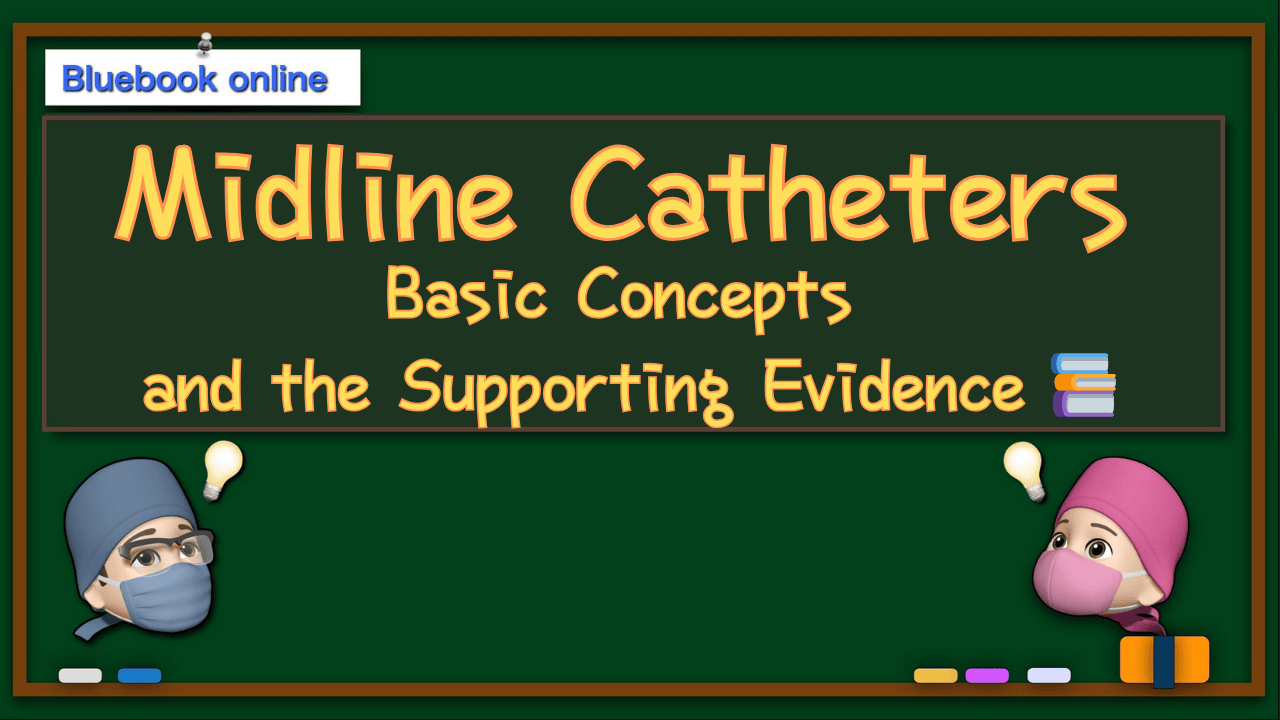👉👉 🇺🇸 All Posts 🇬🇧 / 🇯🇵 記事一覧 🇯🇵 👈👈
♦️ Introduction
 まっすー
まっすーDoctor, an inpatient keeps saying ‘the IV keeps falling out’ — the patient is having a hard time with repeated cannulations. Is there a good option other than a PICC?



Lately there’s the midline catheter. It’s more reliable than a standard peripheral IV and less invasive than a PICC — a true ‘middle’ option. Practical for short-to-medium term vascular access.



Got it. I’ll place one tonight.



Don’t call it a ‘midnight’ catheter, OK? 💢
Midline catheters first appeared in the 1950s as a relatively old vascular access device: a longer peripheral catheter inserted from a peripheral vein whose tip does not reach the central veins (SVC).
Initially inserted only by physicians, they largely disappeared from routine use for a while.
Recently, however, adoption of ultrasound guidance and reappraisal of complication risks versus PICC/central lines have brought midlines back into clinical attention.
From the late 2010s into the 2020s they have increasingly been used as a practical “middle” option for short–to–mid-term venous access, for example for about 5–14 days in many settings.


♦️ Overview of Midline Catheters
🔷 Definition
A midline catheter is a peripheral venous catheter inserted—typically from the upper arm (basilic, cephalic, or brachial territory)—with the tip positioned in axillary to proximal brachial veins.
The key point is that the catheter tip does not reach the intrathoracic central veins (SVC). Catheter lengths vary by product (a few cm up to around 20 cm are commonly used).
Clinically they are intended for short-to-mid-term dwell time; many facilities and guideline summaries cite an expected dwell range roughly between 5 and 14 days. This positioning and intended duration are described in standards such as the Infusion Nurses Society (INS) guidance and multiple review articles.
🔷 Indications and Contraindications
Clinical decision-making around use of a midline is commonly based on three main considerations:
- Whether the medication can be safely administered via peripheral veins (check pH, osmolality, and whether the agent is a vesicant).
- Planned duration of therapy (short / mid / long term).
- Patient thrombotic risk and vein quality.
Practically, midlines are suitable for medications that are safe peripherally (for example many common antibiotics) when infusion is expected to continue for a few days up to about two weeks.
Conversely, strong irritants/vesicants, high-osmolar solutions, and long-term parenteral nutrition (TPN) are best given via central access (PICC or central venous catheter).
Patients with prior deep vein thrombosis or very high thrombosis risk, and those who may require future dialysis access, require careful individualized assessment before choosing a midline.
🔷 Insertion Technique and Practical Management: Key Points
Insertion is recommended under sterile conditions with ultrasound guidance. A typical workflow is:
- Verify anticoagulation status.
- Ultrasound assessment of the target vein.
- Sterile skin preparation and ultrasound-guided puncture → guidewire insertion → catheter placement.
- Confirm tip position (x-ray/fluoroscopy or ultrasound).
- Secure dressing, flush, and document.
While learning the procedure, particular attention to vein assessment, securement/ fixation, and flush frequency reduces early mechanical complications (occlusion, dislodgement, leakage). Follow your facility’s protocol on flush volumes and whether heparin lock is used. Standardize documentation and daily site checks.
🔷 Advantages of Midline Catheters👍
Observational studies and systematic reviews report several practical benefits:
- Fewer punctures and more stable IV access compared with repeated peripheral cannulation, which often leads to improved patient satisfaction.
- Compared with PICCs, some observational and meta-analytic reports suggest a lower rate of catheter-related bloodstream infection (CRBSI) with midlines, although findings vary and context matters.
- Useful for patients with difficult peripheral access who do not require central administration of infusates.
🔷 Disadvantages and Risks😫
Major midline complications include infection, thrombosis, occlusion, and extravasation.
Recent systematic reviews and larger trials show that while midlines may trend toward lower CRBSI, overall complication rates and thrombotic outcomes differ across studies; therefore midlines are not universally safer in every metric.
Preventing complications relies on sterile insertion, appropriate dressing care, adherence to flush protocols, and daily site monitoring. Remember also that because midlines do not reach the central circulation, they are not appropriate for TPN or certain vesicant/irritant agents.
🔷 What to Do If a Complication Is Suspected🚨
Suspected infection (erythema, warmth, fever):
Stop using the line, inspect dressing and catheter site, obtain peripheral and line blood cultures from the line and peripheral site. If clinical sepsis or lack of improvement is suspected, consider prompt catheter removal.
Suspected occlusion:
Follow your facility’s flush protocol (typically saline flush); if occlusion persists, evaluate for kinking, malposition, or securement problems. If mechanical issues are found, consider re-placement.
Suspected thrombosis (swelling, local pain):
Stop use immediately and assess with ultrasound. If deep venous thrombosis or high clinical risk is confirmed, involve vascular surgery or cardiology to consider anticoagulation and further management.
Because reported thrombosis rates vary across studies, follow your institutional guidelines for diagnosis and treatment.
♦️ Choosing Between PIV, Midline, and PICC
In clinical practice, decide based on three factors: drug irritability, planned duration of therapy, and thrombosis/vein risk.
- Short term (a few days) where peripheral administration is acceptable → PIV is first-line. Don’t force multiple attempts if access is difficult.
- Several days to ~2 weeks for meds that can be given peripherally → Midline is practical, especially when patient transfer or repeated dwell is anticipated.
- ≥14 days, or when TPN / vesicants / high-osmolar infusions are required → PICC or central venous catheter is indicated.
♦️ Current Evidence
There has been growth in observational studies, randomized trials, and systematic reviews comparing midlines and PICCs. Differences in study design and outcome definitions lead to heterogeneous conclusions.
Many guideline summaries accept midlines as useful but rate the overall strength of evidence as low–moderate; final decisions are usually individualized to patient context and institutional practice.
📝 Summary:Take Home Points
- Midline catheters occupy a practical middle ground between peripheral IVs and PICCs for short-to-mid-term vascular access.
- Assess whether the medication is safe for peripheral administration (pH / osmolality / vesicant status), planned dwell time, and the patient’s thrombosis risk before choosing a midline.
- Evidence suggests a tendency for lower CRBSI with midlines compared with PICCs, but thrombosis and other complication rates vary across studies — follow local data and protocols.
- Preventing complications requires sterile insertion, securement, appropriate flushing, and daily site monitoring.
📚 References & Further reading
- [1] Gorski LA, Hadaway L, Hagle ME, et al. Infusion Therapy Standards of Practice (8th ed.). Infusion Nurses Society; 2021. (INS standards — indications/contraindications and procedural guidance for midline catheters.)
- [2] Urtecho M, Torres Roldan V, Nayfeh T, et al. Comparing complication rates of midline catheter vs peripherally inserted central catheter: a systematic review and meta-analysis. Open Forum Infect Dis. 2023;10(2):ofad024. (Midline shows lower CRBSI tendency but higher superficial thrombosis in some reports.).
- [3] Thomsen SL, Boa R, Vinter-Jensen L, Rasmussen BS, et al. Safety and efficacy of midline vs peripherally inserted central catheters among adults receiving IV therapy: a randomized clinical trial. JAMA Netw Open.2024;7(2):e2355716.
- [4] Lai J-Y, et al. Comparison of complication rates between midline catheters and peripherally inserted central catheters: a systematic review and meta-analysis of randomized controlled trials. J Hosp Infect. 2024;151:131–139.
- [5] Canadian Agency / Rapid Review. Midline Catheters for Administering Intravenous Infusion Therapy (Rapid Review / Health Technology Assessment). 2025. NCBI Bookshelf NBK613813.
- [6] Fabiani A, et al. The longer the catheter, the lower the risk of complications: Results of the HERITAGE study comparing long peripheral and midline catheters. Am J Infect Control. 2024 Nov;52(11):1289–1295.
- [7] Bentridi A, Giroux M-F, Soulez G, et al. Midline Venous Catheter vs Peripherally Inserted Central Catheter for Intravenous Therapy: A Randomized Clinical Trial. JAMA Netw Open. 2025;8(3):e251258.
- [8] Souri Y, Cancino C, et al. Clinical evaluation of the PowerGlide Pro midline catheter — dwell time, complications and outcomes for various medications. [Journal / PMC] 2024. PMC11602871. (Product-based observational study)
Notes on evidence levels:
INS uses Levels I–V for evidence grading (Level I = meta-analyses/systematic reviews; Level II = RCTs; Level III = quasi-experimental; Level IV = cohort/observational; Level V = case reports/expert opinion). Many midline recommendations fall in Level II–IV, with some expert consensus (Level V) for specific procedural recommendations. For example, a 5–14 day suggested dwell time is generally based on Level IV evidence; contraindication for vesicants/TPN is Level III–IV; caution for prior thrombosis or vein preservation cases is often expert consensus (Level V).
Minor editorial note
This translation preserves the structure and clinical content of the Japanese article. If you’d like, I can (1) adapt the language for a specific target audience (e.g., concise clinical guidance for nurses, or a board-exam style primer for residents), (2) format it for WordPress with headings/HTML, or (3) produce the English-version meta tags and an English X/Twitter post (with required hashtags: #Anesthesiology #PerioperativeCare #MedEd). Which of those would you like next?
🔗 Related articles
- to be added

コメントを投稿するにはログインしてください。